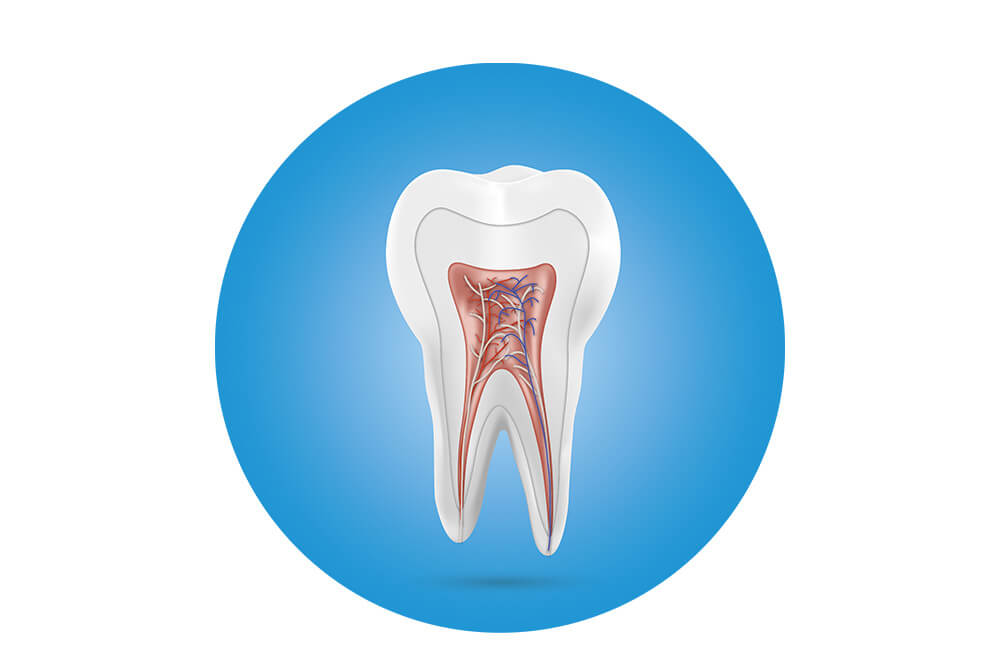Enamel: the protective shield around our teeth
Tooth enamel is the hardest substance in the human body. It protects the teeth from external irritants. Over time, however, our enamel wears away. If it is damaged, this often has painful consequences: it can result in teeth which are sensitive to heat and cold, or cavities.
In this article you will learn what enamel is, what function enamel it has for oral health, how to detect enamel wear and how to restore your own enamel.
What is enamel?
Enamel is the outermost layer of the visible part of the tooth, the natural crown. It is also referred to as enamelum. In adults, healthy enamel is 1.5 to 3 millimeters thick and shields the underlying dentine.
This protective layer is made of up to 97% hydroxyapatite. The main components of this mineral are anorganic substances such as calcium, phosphorus and sodium. The crystalline form of the mineral gives the enamel its resistance and protects the teeth from bacteria and acids.
As enamel does not contain any nerve fibres and blood does not flow through it, it is not sensitive to pain. However, this also means that enamel does not consist of living cells and can thus also not be replaced by the body.
Furthermore, enamel also plays a role in the colouration of the teeth. The high concentration of hydroxyapatite in enamel makes the teeth appear whiter. The crystalline form also gives them a slight glow.
Why is enamel important?
Enamel has to withstand quite a lot: eating, drinking, chewing or other triggers such as tooth grinding are daily stressors. The high strength and resilience of enamel protects the underlying layers of the tooth from wear. However, enamel itself is worn away little by little due to the continuous stress.
If the enamel is damaged, the risk of cavities and other oral diseases increases, which, in the worst case scenario, can lead to tooth loss. Enamel also protects the teeth from demineralisation due to acids which are produced when sugar is broken down.
As enamel does not contain any nerve fibres and blood does not flow through it, it is not sensitive to temperature fluctuations – for example when we consume hot or cold food or drinks or breathe in cold air through our mouths. If teeth react with sensitivity or with a brief, sharp pain, this may well be an early sign of enamel wear. This is caused by exposed dentine channels which transmit the irritation directly to the nerve.
Symptoms of enamel wear
Do you sometimes experience pain when you eat or drink something hot or cold? Do your teeth look more yellow lately, or "transparent" around the edges? These can both be symptoms of damaged enamel:
- The reason for sensitive teeth (in technical terminology, dentine hypersensitivity) is that the dentinal tubules, which are normally sealed by the enamel, are exposed. Unlike enamel, the dentine contains nerves which transmit thermal or mechanical irritants directly, causing unpleasant and sudden pain.
- Discolouration can also be associated with thinning enamel. As a result, the underlying dentine shows through and the tooth appears less white. Under the light, the teeth can even appear slightly transparent. This is particularly noticeable at the corners and edges of the teeth.
- The dentist can also detect cavities in the enamel. This type of cavities, also known as initial cavities, is only superficial and has not yet penetrated the deeper layers of the tooth. It is obviously not yet visible as the more familiar hole in the tooth, but it may turn into one if it is not treated.
What causes enamel wear?
On the one hand, enamel is subject to natural wear: daily chewing and grinding of food causes the enamel to wear down little by little. However, this is an extremely long and drawn-out process. On the other hand, there are also additional factors that promote enamel wear and can lead to premature wear:
- Diet: The most common cause of enamel wear is diet. In industrialised countries, our eating and drinking habits have changed a great deal over the past few decades. Acidic foods and drinks are consumed much more frequently. These can attack the enamel.
- Incorrect brushing technique: If too much pressure is exerted during brushing, this can lead to damage to the enamel in the long term. A toothbrush with hard bristles can also contribute to enamel wear. Toothpastes containing abrasive particles (sandpaper effect) can also damage the enamel.
- Plaque: Plaque: Plaque is the substance that coats the teeth. It consists of saliva, bacteria and the remains of meals and is part of the normal oral microbiome. If it is not thoroughly removed on a regular basis, the microorganisms contained within it metabolise sugar. This produces acids which attack and demineralise the enamel.
- Tooth grinding: Grinding the teeth during the night can also cause enamel wear. The enamel is exposed to enormous pressure due to the pressing together of the masticatory surfaces. The additional friction caused by tooth grinding leads to the wear of the tooth substance. In the worst case scenario, the enamel can be worn to the extent that the underlying dentine is visible. A so-called bite guard can help, and can reduce the pressure.
- Gastric acid:In acid reflux disease, for example heartburn, gastric acid rises into the oesophagus and can even reach the oral cavity. So-called silent reflux, where acidic gases rise up from the stomach, is particularly pernicious. These gases can easily enter the mouth, where they can affect the enamel.
Strengthen the enamel through diet
As hard as nature's enamel may be, acids can nevertheless weaken it when they come into regular contact with the teeth, making it thinner and porous. It is then easier for bacteria to adhere to the surface of the teeth and the risk of dental cavities rises.
Foods with a low pH from 2.5 to 3.5 can foster the demineralisation of the teeth. This includes foods such as apples, strawberries, oranges, grapes, tomatoes or salad dressings containing vinegar. However, the complete avoidance of foods with a low pH is not necessary – especially since unprocessed foods also contain other valuable substances that contribute to a balanced diet.
However, it is easy to help your teeth by eating something that contains calcium after consuming acidic foods. This has a neutralising effect and protects the teeth from wear. This is easily achieved with a little yoghurt or quark, or by drinking milk.
You should also drink water with your meals. This has a neutral pH of 7 to 8.5 and helps to reduce the acid load in the oral cavity. On the other hand, sparkling drinks, energy drinks and other sugary beverages also promote demineralisation, so should be avoided as much as possible.
Strengthen enamel with toothpaste
Unlike hair and nails, which grow back throughout our lifetime, enamel cannot regenerate itself. Studies have proven that the remaining enamel can be effectively strengthened by oral care products containing bionic hydroxyapatite. This is manufactured in the laboratory and has similar properties to the basic building blocks of natural enamel.
During brushing, the biomimetic enamel (hydroxyapatite/BioHAP) in Bioniq® Repair-Toothpaste binds to the surface of the teeth and repairs microscopic defects. Even cavities in their initial stages can be filled. A layer is formed that provides protection from wear.
With regular use of Bioniq® Repair products:
- The formation of plaque and tartar is reduced and cavities and gum problems prevented
- Teeth are less sensitive to hot, cold, sweet or sour food and drink
- Teeth feel smoother as fewer bacteria are able to adhere to the surface
Protect enamel with the correct brushing technique
The choice of toothbrush and brushing technique can also help to protect the enamel: To avoid "sanding down" the enamel, choose a toothbrush which is not too hard and make sure to brush gently. If you are unsure about which hardness is right for you, you can also ask your dentist. Some of the latest electric toothbrushes already tell you if you are brushing too hard.
Wait at least one hour after eating before brushing your teeth. The acids in the food will soften and weaken the enamel. After 30 to 60 minutes, the saliva will neutralise the acids and remineralise the teeth.
Bioniq® Repair products with 20% biomimetic enamel (hydroxyapatite/BioHAP)
You may also be interested in:

Biomimetic enamel (hydroxyapatite/BioHAP)
Our teeth are made of as much as 97% hydroxyapatite. Brush back enamel by using Bioniq® Repair products with 20% biomimetic enamel (hydroxyapatite/BioHAP).

Tooth structure
What does a tooth look like on the inside? And are there differences between molars and incisors? In this article you will discover the structure of a human tooth, find out which areas need special protection during your daily oral hygiene routine and what medical approaches are available to restore your teeth.

Sensitive teeth
Individuals suffering from sensitive teeth know the sudden, flash-like pain which will follow after savouring cold, hot, sour or sweet foods. Here, you will find the most frequent causes for the so-called dentin hypersensitivity and what you can do about it!









